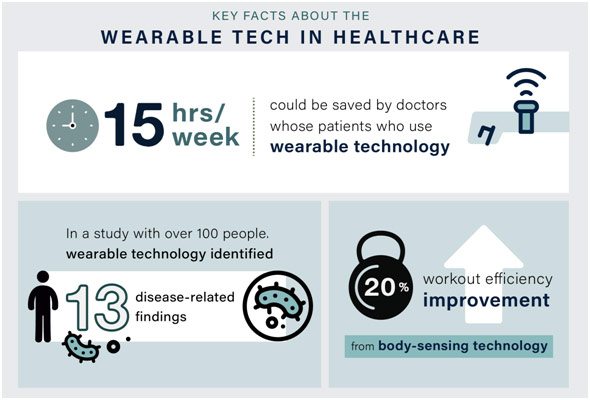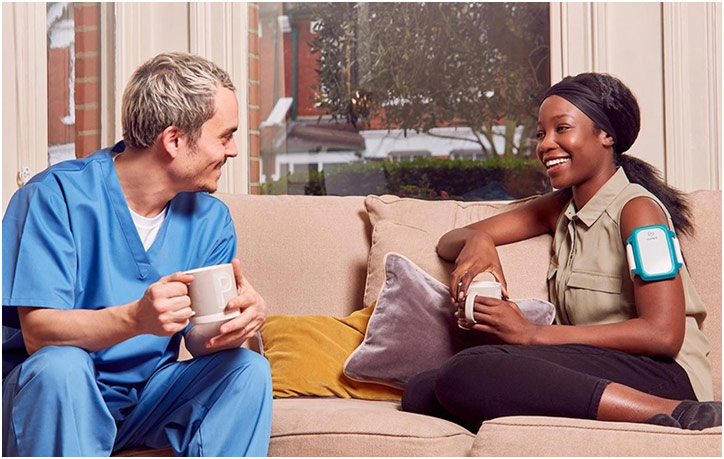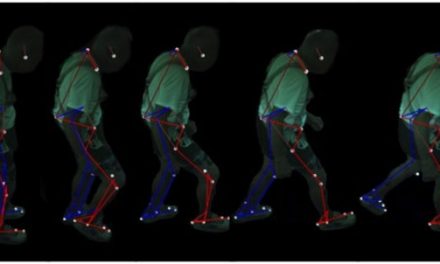
Key Benefits to Wearable Devices in Medicine
Too often, our healthcare system is focused on interventions to combat chronic diseases instead of preventive measures, but wearable devices offer a means to make preventive medicine more feasible and practical. EKG data, for instance, is already being collected by the Apple Watch, which can alert users to an abnormally low or high heart rate and check for atrial fibrillation, an irregular heartbeat with deadly complications. Newer Fitbit, Samsung, and Apple smartwatches are also now able to measure blood-oxygenation levels, which can be an important diagnostic of everything from heart defects to sleep apnea to emphysema. Fitbit’s Sense watch also has the ability to detect electrical changes in the skin through sweat and combine that with other data to calculate a stress management score and recommend exercises to manage that stress. Stress, of course, is a risk factor for countless diseases, which highlights the role wearables can have in combating it. Not only are these smartwatches wildly popular among consumers but also they are already helping to improve care.
Another good example of the preventive aspect of wearables can be found in Nutromics’ smart patch. Their patch sits on the skin and captures nutritional data at the molecular level with microneedles accessing the body’s interstitial fluid to detect dietary biomarkers. Nutritional research has chronically been described as “messy” with different studies giving conflicting results and very few randomized controlled trials, the gold standard of medicine. Nutromics’ smart patch, which is still ways away from being commercially available, would be able to provide targeted nutritional data for each individual person as opposed to studies, which provide aggregated data. The medical potential for this type of technology is truly endless because the diet is such a critical aspect of health, but the possibilities for Type 2 diabetes, a disease that costs the U.S. healthcare system $327 billion a year, is perhaps most salient. The non-invasive monitoring of a patient’s glucose levels with this system, as well as how their body responds to certain foods, might allow for the early monitoring of diabetes and offering dietary suggestions to reduce the patient’s risk for diabetes. This specific application would revolutionize care, especially given the fact that 20% of people with diabetes are unaware they have the disease and 80% of people with prediabetes are unaware they have the condition.
Another exciting example of what wearable devices can achieve is an e-skin developed by California Institute of Technology Professor Wei Gao. This electronic skin can be directly applied on top of real skin and is filled with sensors that can continuously detect heart rate, body temperature, blood sugar, metabolic byproducts, and more, all while being powered by human sweat. The e-skin wirelessly transmits the data it collects, which might down the road be sent to a hospital where an algorithm analyzes the trends and makes risk predictions for certain diseases. Additionally, this “human-machine interface” is really only limited by what sensors can be tacked onto it, the number of which is rapidly rising as hardware becomes increasingly miniaturized. With these devices being so portable and convenient, there can be significant buy-in from patients, especially given that wearables may catch disease and disorder earlier than would otherwise be possible. Silent killers that are often asymptomatic and only present themselves in late stages could be efficiently detected and also then treated.

Electronic Skin Human-Machine Interface
Indeed, disease management could be revolutionized with wearable devices by allowing round-the-clock health surveillance, particularly in helping determine when an adverse event has occurred and accordingly alerting the proper personnel. For example, there are countless wearable devices that can detect if an elderly person has fallen and alert family members, as well as EMTs. Importantly, falling is a widespread public health crisis: falls are the number one cause of fatal injury among older adults. One in four Americans above the age of 65 falls annually with an elderly person dying every 19 minutes from a fall. With an accelerometer, gyroscope, and other technology, these devices can provide 24/7 monitoring to detect any sudden tumbles with some even being able to analyze gait patterns to alert someone if they are at risk of falling down. Similarly, there are stroke detection wearables, such as one developed by Cerebrotech Medical Systems, which can detect severe strokes within seconds and with greater accuracy than emergency personnel in the field can. As a result, stroke patients could get treatment faster, a critically important mission given that time is quite literally brain.
Perhaps most excitingly is Current Health’s platform, which is the first artificial intelligence medical monitoring wearable approved by the FDA. Current provides highly accurate monitoring of respiration, pulse, oxygen saturation, mobility, and temperature all within one device in order to help reduce unnecessary hospital visits and address preventable deaths. Collecting such a plethora of data and having an artificial intelligence system analyze it would allow physicians to keep closer tabs on their patients and intervene more rapidly in case patients’ COPD or heart failure, for example, deteriorates.
Additionally, wearables can help direct care for patients with chronic diseases. For instance, there are several smart insulin patches that can allow Type 2 diabetes patients to achieve glucose control by delivering a continuous infusion of insulin as is needed throughout the day. Having this automatic system in place could reduce potentially fatal incidences of hypoglycemia and hyperglycemia by removing manual management from the equation. Similarly, for pediatric irritable bowel syndrome (IBS) patients, the IB-Stim device helps treat their abdominal pain by sitting behind the ear and emitting electrical pulses to stimulate the nervous system. As abdominal pain from IBS can be difficult to address, the IB-Stim device is game-changing for these patients.

Current Health System in Action
There are truly endless possibilities and avenues through which wearable devices can facilitate the remote diagnosis and treatment of patients, freeing up beds in the hospital and providing quality healthcare at all times. By shining a light on patients’ activities outside the hospital, wearables could allow physicians clearer pictures into their patients’ health, which would have undeniable benefits for patients. Certainly, privacy and security concerns need to be contended with given the vast swaths of data that are being collected, but, with proper safeguards in place, wearable devices seem well-poised to revolutionize healthcare delivery by making it a truly 24/7 venture.
References
American Diabetes Association. “Economic Costs of Diabetes in the U.S. in 2017.” Diabetes Care, Mar. 2018, care.diabetesjournals.org/content/early/2018/03/20/dci18-0007. Accessed 18 Dec. 2020.
Baig, Edward. “Newest Smartwatches Move from Tracking Fitness to Monitoring Health.” American Association of Retired Persons, 28 Sept. 2020, www.aarp.org/home-family/personal-technology/info-2020/smartwatches.html. Accessed 18 Dec. 2020.
Biswas, Satarupa. Wearable Biosensors. Adamas University, adamasuniversity.ac.in/healthcarenext-wearable-biosensors-will-be-the-next-big-thing-in-healthcare-technology/. Accessed 18 Dec. 2020.
Carfagno, Jack. “First AI Medical Monitoring Wearable Approved by FDA for Home Use.” DocuWare News, 24 Apr. 2019, www.docwirenews.com/docwire-pick/future-of-medicine-picks/first-ai-wearable-approved-by-fda-for-home-use-monitoring-vitals/. Accessed 18 Dec. 2020.
Clark, Maria. “15 Healthcare Wearables That Are Straight out of a SciFi movie.” Tactics, 7 May 2020, etactics.com/blog/wearable-technology-in-healthcare. Accessed 18 Dec. 2020.
Crawford, Mark. “Wearable Device Detects Stroke in Seconds.” Alliance of Advanced Biomedical Engineering, 7 May 2018, aabme.asme.org/posts/wearable-device-detects-stroke-in-seconds. Accessed 18 Dec. 2020.
Current Health Platform. Wearable Technologies Conference, www.wearable-technologies.com/2019/12/current-health-raises-11-5-million-in-series-a-funding-round-led-by-mmc-ventures/. Accessed 18 Dec. 2020.
“Fall Prevention Facts.” National Council on Aging, www.ncoa.org/news/resources-for-reporters/get-the-facts/falls-prevention-facts/. Accessed 18 Dec. 2020.
Key Facts about the Wearable Tech in Healthcare. 31 Jan. 2020. Business Insider, www.businessinsider.com/wearable-technology-healthcare-medical-devices. Accessed 18 Dec. 2020.
Nessel, Jennifer. “New Wearable, Patch-Like Insulin Delivery System for Patients with Type 2 Diabetes.” Pharmacy Times, 8 Apr. 2020, www.pharmacytimes.com/news/new-wearable-patch-like-insulin-delivery-system-for-patients-with-type-2-diabetes. Accessed 18 Dec. 2020.
Seymore, Brandeis. “Smart Specialty Wearable Devices Can Boost Patient Care.” Pharmacy Times, 3 June 2020, www.pharmacytimes.com/news/smart-specialty-wearable-devices-can-boost-patient-care. Accessed 18 Dec. 2020.
Velasco, Emily. “Electronic Skin Fully Powered by Sweat Can Monitor Health, Serve as Human-Machine Interface.” California Institute of Technology, 22 Apr. 2020, www.caltech.edu/about/news/electronic-skin-fully-powered-sweat-can-monitor-health-serve-human-machine-interface. Accessed 18 Dec. 2020.















